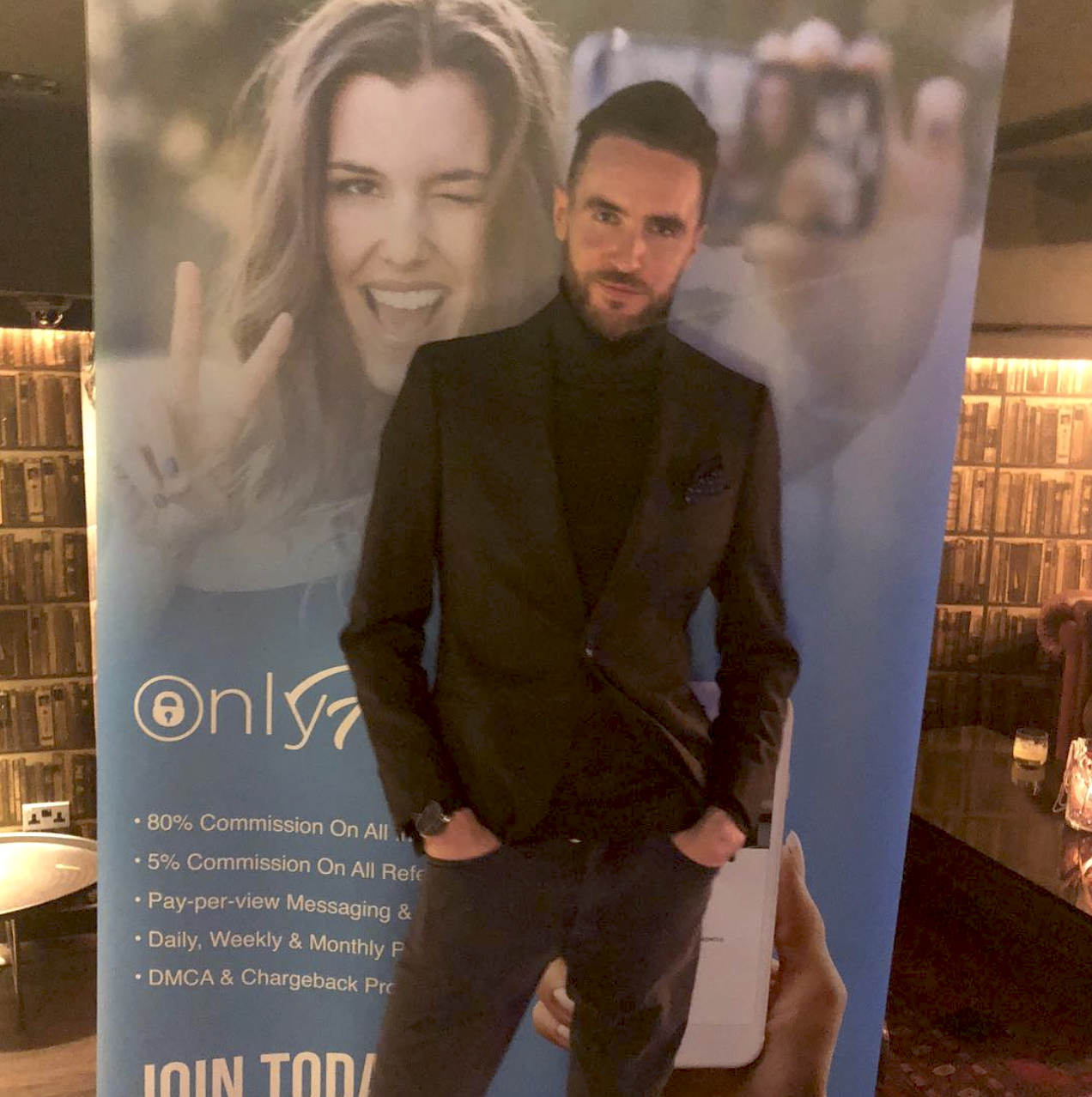OnlyFans and the porn ban. What really happened?
Safe spaces for online sex workers are short-lived because of the complicated and precarious nature of the link between sex and money. Isn’t it time this opaque financial system was overhauled, asks Sean Russell


On the morning of Saturday 21 August 2021, Katie* woke up, looked at her phone and saw an email from OnlyFans. It had been sent the night before and said that by 1 October the social media company would prohibit the posting of any new content containing sexually explicit conduct. It made no sense to Katie, OnlyFans made the majority of its considerable profit through sex workers – but more importantly, in that moment, Katie worried about losing up to half her income. She started chatting to other creators using the platform and found that everyone was worried that this was yet another safe space being taken away from sex workers.
Since its creation, OnlyFans has offered a place where creators were able to sell explicit video clips and images online, allowing them to work the hours they wanted, from home, and take on only the work they felt comfortable with. When the news broke, many began to look for other services such as Fans.ly to replace the lost income.
This is nothing new in the industry. Some of the more experienced creators say that with every new platform that comes along, it’s only a matter of time before sex workers are kicked off and have to go in search of something else.
After five days, during which Tim Stokely, the founder and then-CEO of OnlyFans, blamed its banking partners for the ban, OnlyFans changed its mind. On 25 August, the “porn ban” was over and it was business as usual. But there are many who think this is far from the case. The ban at OnlyFans was another example of how sex work and money is tied together and how this link threatens the livelihoods of sex workers.
OnlyFans has not talked about the porn ban publicly since then, and seems to be moving on from the situation. A new CEO, Ami Gan, previously the company’s chief marketing and communications officer, was installed in December, with Stokely, the so-called “king of homemade porn” stepping down. Gan says she’s now “especially focused on providing unparalleled opportunities for creators to own their full potential by maximising control over and monetising their content as well as reinvesting in the business to continue to stay ahead of the needs of our creators.”
But there are those that fear that the ban could be brought back at a later time and that perhaps there’s no such thing as a safe space for sex workers online because of the highly complicated and precarious nature of the link between sex and money.
The story of OnlyFans is one of incredible success. Started by Tim Stokely in 2016 with £10,000 given to him by his banker father, Guy, it is perhaps uniquely successful as a British social media company. According to Axios, an American news website, and data taken from an OnlyFans’s pitch-deck, the platform has more than seven million fans spending money each month, and even more accessing free content. Its net revenue in 2021 was $1.2bn and it expects to grow to $2.5bn in 2022.
The idea was simple. Sites such as Facebook, Twitter and Instagram all have creators working tirelessly to build careers. Why not monetise it? Subscription models such as Netflix and Spotify have shown people are willing to pay for content, why not pay for access to a particular person’s feed? It was envisioned for creators such as yoga teachers and chefs to sell their content, but it has always been all-inclusive and didn’t exclude sex work.

However, the fact that users must be over 18 to have an account, and due to its private nature – one has to subscribe to a creator to access content – it soon became a favourite of glamour models and the wider sex and porn industries. People wanted to pay for access to people’s explicit content and they also wanted to pay for “custom” videos for an agreed price. This is what made OnlyFans the platform of choice for many sex workers.
Maria* is a sex work veteran, having been in the industry for 18 years, starting in glamour modelling. She joined OnlyFans because all the models she knew were doing it, and throughout her career she has always tried to diversify her business. She told me that after five years of hard work, she now makes nearly £20,000 a month from OnlyFans alone, much of which is from custom videos.
This money-making ability was concentrated when lockdown struck in March 2020. Instead of work drying up for those models who would have originally travelled around the country to different shoots, they were able to work from home safely. Meanwhile, sign-ups to the service boomed with people stuck at home seeking adult content.
Ariel Anderssen has also been modelling for 18 years and joined OnlyFans in 2016. She told me that the platform allowed sex workers to be able to humanise themselves like never before. She says that it was an opportunity to socialise and speak with her customers, which was laid bare during the pandemic when many felt lonely. What people wanted was authenticity.
I film in my house, so they get to see it. They see my husband when he walks through. We talk about physical and mental health problems and it’s been a new angle to my career that I didn’t see coming
“I film in my house, so they get to see it,” said Anderssen. “They see my husband when he walks through. We talk about physical and mental health problems and it’s been a new angle to my career that I didn’t see coming. I’ve discovered some lovely friendships through it.”
Katie has been an adult model for six years now and also speaks warmly of OnlyFans. She tells me about her career before the platform came along. She spent time in multiple jobs looking for flexible work that she could build around studying. She’d been working in pubs and restaurants before stumbling across an advert for adult modelling. She decided to give it a go and loved it. But as time went on, spending three weeks out of the month in hotels on shoots, often in poor conditions, began to affect her. She says it made her terribly home sick and although she enjoyed the work, it was hard.
With the coming of OnlyFans came a new period of her life where she could work when she wanted and create only the sort of content that she enjoyed. She also made significantly more money and all from the warmth of her home. This had a knock-on effect for the rest of the industry, with production companies changing in response to OnlyFans.
“Producers are trying to make shoots better for everyone now,” she says. “They’re paying more and they’re just making everything they do more ethical and shoots more enjoyable so we want to go and work for them.”
It seems that OnlyFans may well have changed the wider industry for the better.

Nor does it stop there. Ariel told me that if you look at the top 1 per cent of sex-work earners on OnlyFans they represent a diverse bunch of people: different sizes and ethnicities, a diversity that might not be seen in the top 1 per cent of professional glamour models. It wasn’t just the creators that benefitted from this. OnlyFans became a billion-dollar company. OnlyFans doesn’t charge for opening an account, but it takes a 20 per cent commission on all money made and it has so far paid out over $5bn to creators.
So why would a platform, founded by the “king of homemade porn” and making considerable amount of profit from sex work, initiate a porn ban? The answer to this perhaps lies not with OnlyFans but with the way our financial system is built against industries such as sex work.
Stokely was born in 1983 in Essex. His father is a 77-year-old former investment banker who once worked at Barclays. Stokely didn’t follow his father into banking but saw himself as something of an entrepreneur. He refers to Warren Buffet as his idol and has set up multiple companies in his short career. This began with sites such as GlamGirls and Customs4U, a platform selling custom-made porn videos – perhaps a precursor to OnlyFans,
It was obvious that Stokely saw an opportunity in sex work and models. And, Maria believes, in some ways he revolutionised the industry in the UK.
In 2016 Stokely spotted another opportunity in monetising social media. According to the Financial Times, he asked his father, Guy for another loan. His father replied: “Tim, this is going to be the last one,” and then Stokely was off to set up a UK-based social media company to rival the likes of Twitter and Facebook.

It wasn’t long before OnlyFans began to soar. There has been a marked swing toward paying for content. More and more media organisations are putting up pay walls and selling subscriptions. The rise of Substack, Patreon, and crowdfunding shows people are willing to pay; Stokely got in early with bringing this model to social media.
On Twitter, to make money one needs to direct followers towards other means, to purchase products for example. Sex workers on Twitter can advertise there, but then bring people to paying sites, or have them buy things on an Amazon wish list. But if you are a chef or yoga teacher or sex worker, the product is the content and that is what should be sold. Sex workers, often highly skilled entrepreneurs used to diversifying, realised this very quickly and it wasn’t long before OnlyFans developed a reputation as the “porn” social media site.
In 2018 Leonid Radvinsky, a Ukranian-American businessman, bought a 75 per cent share in OnlyFans. This is important because Radvinksy, like Stokely, has a history in the porn industry which dates back to the 1990s, according to a profile in Forbes magazine, and includes creating the site MyFreeCams for live camming. It has been suggested that since his arrival at OnlyFans, the platform became increasingly focussed on “not safe for work” content. However, Radvinksy seems to have never given an interview himself.
Since its creation in 2016, sex workers have flocked to the site. Dr Elissa Redmiles, from the Max Planck institute for software systems, tells me that the ease of setting up an OnlyFans account and receiving payment, alongside the large brand awareness that comes with it, led many sex workers to join the platform. A view supported by the sex workers I spoke to who said the pure size and simplicity of it drew them in.
This is people’s online workplace, and to have your workplace taken away from you with a few weeks’ notice was very impactful, powerful and frightening for the creators
Maria had to home-school during Covid lockdowns so she found that she couldn’t use cam sites to make money as much, it took up a lot of her time and she felt like she would have to disappear for long periods of time to do it. With OnlyFans she was able to film all the clips and take all the photos she needed in one session and drip feed them out throughout the week, meaning she could earn money and home-school her child.
“I wouldn't feel like a dreadful parent just shoving my child on his PlayStation with a tray of snacks for the afternoon,” she told me.
So when the porn ban was announced there was mass shock among the creators. “I had some messages from my friend saying ‘what the F***, have you seen this?’ And I was like no, this is not true, this is not happening,” said Maria.
“You absolute cowards,” thought Anderssen who quickly moved to assure her fans that she wouldn’t stop posting content, even if the content was less sexually explicit, (nudity wasn’t banned).
“Their feelings about it were really powerful and it was real fear,” said Vaughn Hamilton, a research associate who works with Redmiles at the Max Planck institute. “This is people’s online workplace, and to have your workplace taken away from you with a few weeks’ notice was very impactful, powerful and frightening for the creators that we spoke to.”
Stokely was quick to interview with the Financial Times to lay the blame not on OnlyFans but on its banking partners, and in the email sent out to all creators, the one that Katie woke up to that morning in August, it said:
Due to the size and rapid growth of the OnlyFans platform, where creators have earned over $5 billion dollars since inception, we must increasingly rely on large banking institutions and payment processors to facilitate payments between fans and creators. The new rules are necessary to comply with the requirements of these financial institutions and are the only way to help ensure the long-term sustainability of OnlyFans.
To understand this we have to look at the banking system and its relationship with sex work. When money changes hands electronically, a payment service provider is required. This is usually a bank which will essentially take the money from the customer, and then transfers that money to the business’s account. This costs the business a certain amount of money. The amount of money it costs depends on the risk that business poses for chargebacks.

Chargebacks are what happens when a customer asks for a refund. In these situations a cost is involved which the bank will absorb for the business, therefore, banks prefer low risk of chargeback industries and will sometimes put this in their terms of service, or factor it in to a higher price for the business to pay.
Sex work is regarded as high risk with a 2 per cent chargeback possibility. Why? Dr Lana Swartz, who studies money’s role in social media at the University of Virginia in the US and wrote the book New Money, describes “friendly fraud” – requesting refunds because of embarrassment, regret or the desire to get something for nothing. This is partially what makes sex work and porn websites high risk alongside a history of sketchy and fraudulent business models.
People do not like to be seen to spend money on porn, they do not like to see it on their credit card reports and if someone’s partner finds a payment for porn on their card the “guilty” party denies it was them, that someone used their card and therefore requests a refund through the company or bank. Likewise, if someone spends a lot of money on porn one night, they may well wake up regretting it and try to get their money back.
People also do not trust porn websites with their money, so there is always a higher risk of refunds. “Sex work and pornography are considered high-risk transactions, and the way high-risk is inscribed into terms of service, and algorithmically enforced, is that it’s simply banned,” says Swartz.
This terms-of-service algorithm-led approach has a lot of other unintended problems. Swartz recounts the story of a new sales business which went from $0 to $20,000 in a week and immediately its accounts were frozen and closed, because the technology believed it was fraudulent.
“These systems were designed to be ok for most people most of the time,” says Swartz. “But anyone or anything that falls outside of the norm or is captured in the drag-net of high-risk transactions is going to find themselves in a tricky situation because of the way these systems have been designed.
“There are outdated models of risk being applied. These models were designed to assess a merchant’s risk of chargebacks and determine how much they should be charged to receive payments. Now they’re being used as blanket assessments for all users. Not to determine the cost of payments but to exclude them from the system all together.”
That we have not come up with a way to handle so-called “high-risk” transaction is a real failure Swartz says.

OnlyFans is perhaps a good option for many. It shows up as OnlyFans on any credit card bill, which is far less obvious than, say, “Porn Hub”. But the issue might be that as OnlyFans became known for porn, and the sight of “OnlyFans” on a credit card statement came with more risk. This would affect OnlyFans’s relationship with its banks, either costing it more to use those bank, or risking being dropped altogether by these catch-all terms and conditions. For a company on the upsurge, trying to expand and attract new users this could make it hard. They need a way to take payments for all types of content, not just sex-work.
This is not just an OnlyFans problem, and Swartz believes that it is possible for a large enough company with a lot of money to negotiate an exception in the terms of conditions or lower rate. Perhaps this is what happened when OnlyFans blamed the banks publicly. When Stokely named JP Morgan, BNY Mellon, and Metro there was an uproar among sex workers and the media jumped on the situation and the decision was widely and very publicly condemned. When they backtracked on the ban, OnlyFans said that they had received “assurances” from their banking partners that would allow them to continue supporting sexually explicit content.
Another issue could be finding investment. Axios reported in 2021 that OnlyFans “has tons of users, but can’t find investors”. It says that while its success is well know, external investors are “content to watch its success from afar”. For a company wishing to expand this is not good news. Axios also states that venture capitalist funds are often banned from investing in anything seen to be porn. This could well be a hurdle for OnlyFans to overcome to grow.
When asked about the porn ban she said that OnlyFans without porn is like McDonald’s without hamburgers
An OnlyFans spokesperson said: “OnlyFans is an inclusive platform, and we are proud to empower creators from all genres to own their potential. Any talk of investment is speculation, if and when we have something to announce we will.”
There are other issues in the banking world. So much of the money has to move through America where right-wing religious anti-porn lobbying groups hold sway. There is nothing illegal about selling explicit videos and images in the UK (so long as those images are of consenting adults and within certain boundaries). But some countries prohibit this form of sex work. Therefore, international banks through their own policies are essentially outlawing sex work in countries where it is totally legal and legitimate. In the case of US banks this essentially takes US morality and enforces this upon UK workers.
“Many forms of sex work are illegal in the US,” said Redmiles, “but they’re not necessarily illegal in places where those apps are being used. There are people who are in, say, Germany, and they are registered as sex workers with the government. Why are they not able to use international technologies? It’s because of the terms of service of that technology, that’s based in the US.”
With the world totally connected with the internet and globalisation it is hard to see how these systematic biases within the financial system can be overcome. We are facing a situation where a country allows money to be made in a certain way, but where the financial system essentially outlaws it with its own terms and conditions.
What is the answer? One could be cryptocurrency but this has its own issues. Redmiles has explored this in her research too and found that the problem is that it can be complicated and even if a sex worker wants to use it there is no guarantee the customer will. There’s also the fundamental issue that one cannot pay rent in crypto.
So, is OnlyFans guilty of turning its back on sex workers? Perhaps, but it is a symbol of a wider financial system that has turned its back on sex workers, had it ever been looking at them in the first place. Time and time again, sex workers find a safe space only for it to be taken away from them.
OnlyFans is not wholly innocent. Dr Emily van der Nagel, a lecturer in Social Media at Montash University in Australia, and co-author of the book Sex and Social Media, has conducted research into how OnlyFans markets itself and says that sex work is not used or mentioned in any marketing material OnlyFans puts out through its main channels and you will struggle to find a single mention of sex work on OnlyFans’s website with perhaps the exception of pole dancing.
There is a real opportunity for OnlyFans to be a platform that says ‘we are for nudes, we are for sexy showing off and we’re for adult content creators and porn creators and sex workers’
Van der Nagel calls this “competing platform imagery”, the idea that there is a disconnect between how a platform presents itself and how it is perceived. Through her research she believes this applies to OnlyFans. When asked about the porn ban she said that OnlyFans without porn is like McDonald’s without hamburgers.
“If people have this understanding, OnlyFans means ‘not safe for work’ and then OnlyFans says ‘here are top five content creators to follow in October’ and there’s a photographer, a fitness instructor and a chef, that is disingenuous. It doesn’t vibe with what people know about the platform.
This may well be a part of trying to appease the banks and entice investors who are part of the same system which discriminates against sex workers. But one could question whether OnlyFans could do more to stick up for sex workers.
In response to a question about its marketing the OnlyFans spokesperson said: “OnlyFans is an inclusive platform that is a safe home to a range of creators from all genres.”
“There is a real opportunity for OnlyFans to be a platform that says ‘we are for nudes, we are for sexy showing off and we’re for adult content creators and porn creators and sex workers,” says Van der Nagel. “But OnlyFans’s purpose here seems to be that people can do whatever they want with the platform. I feel like that does a disservice to the people who have made the platform so popular.”
It might be a case of being between a rock and a hard place for OnlyFans. The platform wants to expand so it needs banks and investment, but it may well need sex workers to expand, and the financial system seems to look unfavourably on sex work.
However, when questioned about how much of an impact banks have on their terms, an OnlyFans spokesperson said: “OnlyFans sets its own Terms of Service that are designed to ensure the respect, integrity, safety, accountability and empowerment of our community.”
As it stands, OnlyFans is perhaps uniquely placed as a household name on the forefront of this fight between traditional financial systems and ‘new money’ sex work
Katie doesn’t feel secure on OnlyFans anymore, nor do Ariel or Maria. It feels like a house of cards waiting to collapse, and they’ve all been in the industry long enough to know that it’s only a matter of time before the financial system chases them out of other businesses they helped make successful.
All three had diversified their portfolios, knowing that nothing is secure within sex work. But now they are diversifying further so they do not rely wholly on OnlyFans. Fans.ly is one that many sex workers moved over to immediately. So quickly in fact that a conspiracy theory was passed around that Stokely also owned Fans.ly. There is no evidence at all for this, it is, perhaps, just a symptom of the distrust sex workers feel for platforms.
“I don’t think any of us were that surprised by OnlyFans’s behaviour,” said Anderssen. “They’ve never wanted to shout about the fact that it was primarily sex workers using their platform, so I’d always been suspicious of them.”
A spokesperson from OnlyFans said it was not true that it was only a matter of time before another ban was attempted. “OnlyFans only bans creators who violate the law or our Terms of Service,” they said. “OnlyFans’ core mission is to empower creators – all creators – to own their full potential and our actions reflect our values. We are inclusive of creators across all genres and we work to maximise our creators’ and fans’ freedom by working to ensure the safety, privacy, and well-being of our community.”
The social media network is looking forward and addressing issues that have concerned creators and customers alike, as part of their mission to be the “safest social media platform in the world”. As it stands, OnlyFans is perhaps uniquely placed as a household name on the forefront of this fight between traditional financial systems and “new money” sex work.
The OnlyFans spokesperson pointed out that “OnlyFans is the only social media platform inclusive of content creators from all genres”. And it is currently holding true to this, even if it might not fully embrace sex workers. But the creators know how the system works, they’ve seen it happen before, and they still fear a ban will happen again. And next time it could be permanent.
* Some names have been changed to protect identities
Join our commenting forum
Join thought-provoking conversations, follow other Independent readers and see their replies
Comments



Bookmark popover
Removed from bookmarks